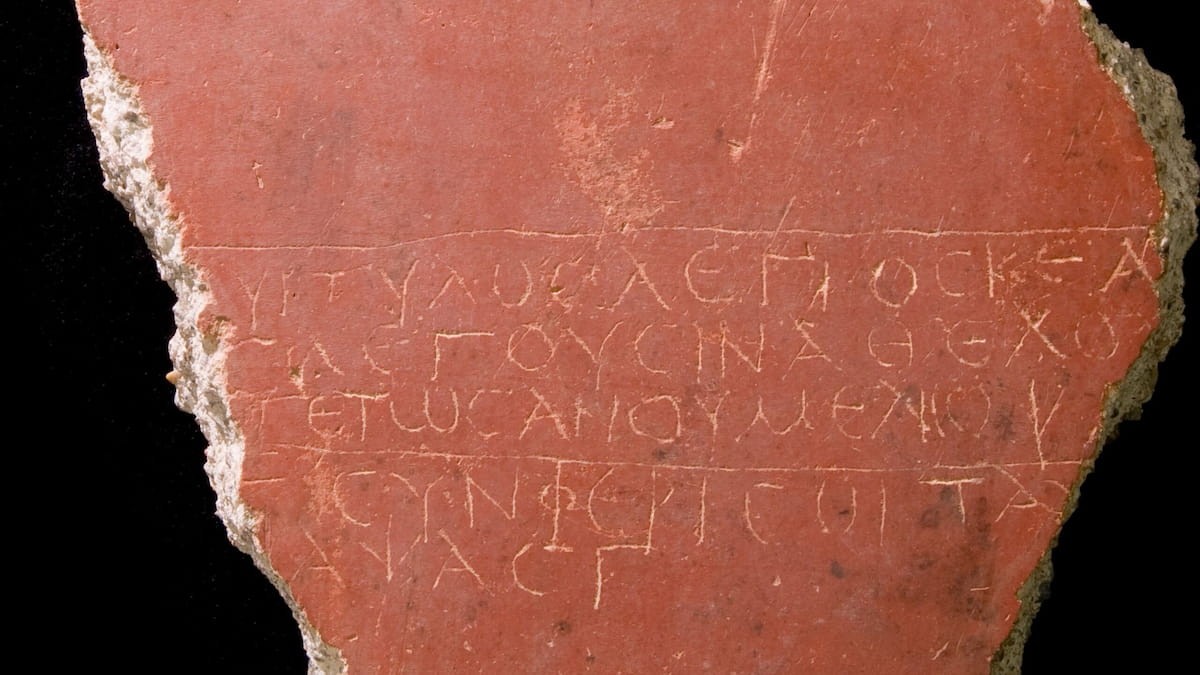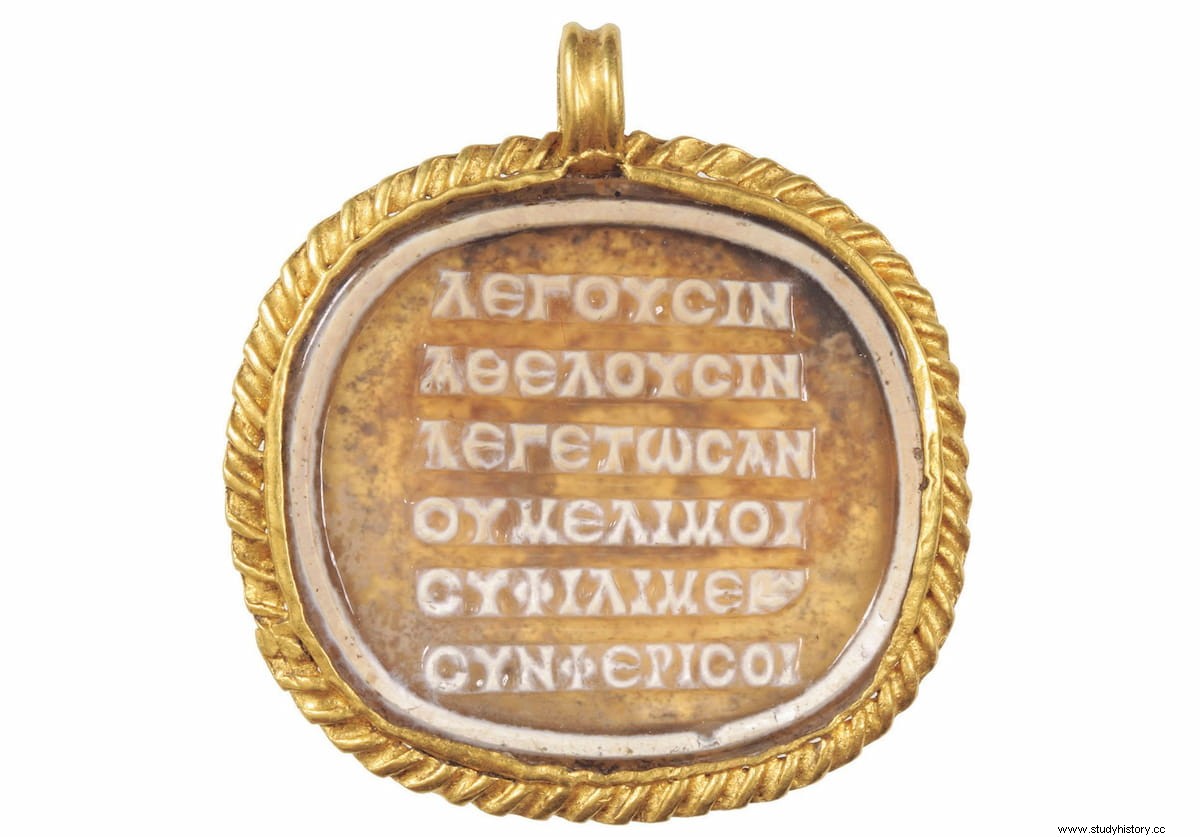New research on a little-known text written in ancient Greek shows that "accented poetry «, predecessor of all modern poetry and song, was already used in the second century of our era, 300 years earlier than previously thought.
In its shortest version, the four-line anonymous poem reads «they say what they want; let them say it; I don't care «. The experimental stanza became popular throughout the Eastern Roman Empire and survives because, in addition to being shared presumably orally, it has been found inscribed on twenty gemstones and as graffiti in Cartagena, Spain.
Comparing all known examples for the first time, Cambridge professor Tim Whitmarsh realized that the poem used a different form of meter than is customary in ancient Greek poetry. In addition to showing signs of the long and short syllables characteristic of quantitative verse Traditionally, this text used stressed and unstressed syllables.
Until now, the «accented poetry » of this type was unknown before the 5th century, when it began to be used in Byzantine Christian hymns.
Professor Whitmarsh states:No specialized poets were needed to create this kind of language set to music, and the diction is very simple, so it was clearly a democratizing form of literature. We are getting a glimpse of an exciting form of oral pop culture that lay beneath the surface of classical culture.
The new study, published in The Cambridge Classical Journal , also suggests that this poem could represent a missing link between the lost world of oral poetry and song of the ancient Mediterranean and the more modern forms we know today.

The poem, unparalleled so far in the classical world, consists of lines of 4 syllables, with a strong accent on the first and a weaker one on the third. This allows him to fit the beats of numerous pop and rock songs, such as Johnny B. Goode by Chuck Berry.
Whitmarsh states:We have long known that there was folk poetry in ancient Greek, but much of what survives is in a form similar to traditional high poetics. This poem, on the other hand, points to a different and flourishing culture, mainly oral, which fortunately for us in this case was also embodied in a series of precious stones .
Asked why the discovery hasn't been made sooner, Whitmarsh says:These artifacts have been studied in isolation. Gemstones are studied by one group of scholars, inscriptions on them by another. They have not been seriously studied before as literature. People who study these pieces don't usually look for changes in metrical patterns.
Whitmarsh hopes scholars of the medieval period are satisfied:he confirms what some medievalists had suspected, that the dominant form of Byzantine verse developed organically out of changes that occurred in classical antiquity.
In its written form (which shows some minor variation), the poem reads:
The gemstones in which the poem was inscribed were generally agates, onyxes, or sardonyxes, all varieties of chalcedony, an abundant and relatively cheap mineral throughout the Mediterranean region.
Archaeologists found the most beautiful and best-preserved example around the neck of a young woman buried in a sarcophagus in present-day Hungary. The gem is now kept in the Aquincum Museum in Budapest.
Whitmarsh believes that these written accessories were mostly purchased by people from the middle ranks of Roman society. He argues that the distribution of gemstones from Spain to Mesopotamia sheds new light on an emerging culture of mass individualism characteristic of our own late-capitalist consumer culture.
The study indicates that they say what they want; let them say it; I don't care it is almost infinitely adaptable, to fit virtually any countercultural context. The first half of the poem would have resonated as a claim for philosophical independence:the validation of an individual perspective against popular belief.

But most versions of the text have two more lines that make the poem go from speaking abstractly of what they say. to a more dramatic relationship between you and me . The text avoids determining a specific setting, but the last few lines strongly suggest something erotic.
The meaning could simply be interpreted as show me affection and you will benefit from it , but, according to Whitmarsh, the words they say they demand to be reread as an expression of society's disapproval of an unconventional relationship.
The study suggests that the poem allowed people to express defiant individualism, differentiating themselves from trivial gossip. What mattered instead was the genuine intimacy shared between you and me , a sentiment malleable enough to fit virtually any wearer.
However, these claims of anti-conformist individuality were pre-ordained, primarily because the sloppy rhetoric it was taken from high literature and philosophy, suggesting that the owners of the poetic gems cared, after all, about what the literary classics said. And, secondly, because the gems themselves were mass-produced by workshops and exported throughout the world.
Whitmarsh states:I think the poem appealed because it allowed people to escape local pigeonholing and claim participation in a network of sophisticates who 'understood' this kind of playful, sexually charged discourse .
The Roman Empire radically transformed the classical world by interconnecting it in every possible way. This poem does not speak of an order imposed by the imperial elite, but of an ascending popular culture that spreads throughout the empire. The same conditions allowed the spread of Christianity; and when Christians began to write hymns, they would have known that poems in this accented form resonated with ordinary people .
Whitmarsh made the discovery of him after finding a version of the poem in a collection of inscriptions and tweeting that it looked a bit like a poem, but not quite. A Cambridge colleague, Anna Lefteratou, a native Greek speaker, replied that she reminded her of later medieval poetry.
Whitmarsh says:That prompted me to dig below the surface and once I did these links with Byzantine poetry became increasingly clear. It was a lockdown project really. I wasn't doing the normal thing of running around with a million ideas in my head. I was stuck at home with a limited number of books and obsessively rereading until I realized this was something really special .
There is no world catalog of ancient inscribed gemstones, and Whitmarsh believes there may be more examples of the poem in public and private collections, or waiting to be excavated.
